Inventor's Fair: My Best Designs
The Inventor's Fair is a weekly Magic: The Gathering custom card contest hosted on Tumblr. Each week, one of a rotating pool of judges creates a contest prompt, and then people submit their entries. At the end of the week, the cards are judged and winners are chosen. To find out more, see this week's prompt, and participate, head over to the Inventor's Fair blog.
This page is a catalogue of my best performing designs for the weekly Inventor's Fair Magic: The Gathering custom card contest— mostly those that are put in the winner's circle or those that are runners-up. For each design, I'll give the card itself, the judge's comments, and a sketch of the underlying concept and the thought process that got me to the final design. I'll also add a note on any revisions that it underwent thanks to critiques on the Inventor's Fair discord server, as well as any notes on why I think this design was stronger than other designs that haven't faired so well.
Entries are presented in reverse chronological order (i.e. newest to oldest). The links below can take you directly to any entry.
Change of Scenery (Winner—Spectrum Supreme)
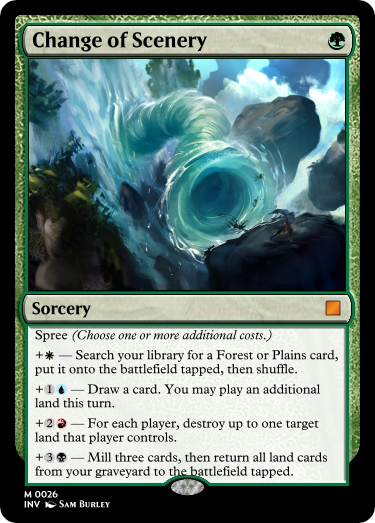
Change of SceneryG*
Sorcery
Spree (Choose one or more additional costs.)
+W—Search your library for a Forest or Plains card, put it onto the battlefield tapped, then shuffle.
+1U— Draw a card. You may play an additional land this turn.
+2R— For each player, destroy up to one target land that player controls.
+3B— Mill three cards, then return all land cards from your graveyard to the battlefield tapped.
Art by Sam Burley
The prompt this week was to design a nonlegendary card with a five-color color identity.
Right out the gate, I knew I didn't just want to do a WUBRG costed card—I'd already been playing around in that design space for an entry for another week that I never actually submitted, and I often find WUBRG designs tend too easily towards just feeling like 'good stuff'. No, I wanted a bit more focus in the design for this kind of challenge.
My first idea was an X-costed creature that gained different types of counters based on the colours of mana spent on it, and while I felt like my version of this card was pretty elegant, it also felt like very low hanging fruit, and a check in on the Discord found several others brewing a similar idea, some much more elegant than mine! So I decided to leave this idea to those who were producing stronger designs with it and explore a different space.
This led me to the Spree mechanic from OTJ. I liked the idea of a different spree cost for each colour, representing different takes on a single core theme. Early iterations tried to have five colour effects that each represented a 'core' ability of that colour, but I quickly found this too felt unfocussed and 'good stuff'-y. So I took a step back and had a think about flavour.
This eventually led me to an idea I initially drafted under the working title, 'Drastic Terraforming'—a card representing a sudden,
magical transformation of the landscape. As a lands card, it felt natural to make the card core-Green, and that left four optional Spree costs,
each of which added an extra colour and a varying amount of generic mana. Each of the Green+ pairs naturally lent itself to a particular kind of
land interaction. For Selesnya (WG), cards like Knight of the Reliquary
and
Krosan Verge
highlight land
tutoring with a particular focus on Forests and Plains. Simic (UG) is core for Explore-type effects, as shown by Joint Exploration
and the various
Growth Spiral
variants. Red
is, of course, the colour of land destruction, and Gruul (RG) also has this as a core capability, with cards like Frenzied Tilling
as my main
inspiration. Lastly, Golgari (BG) isn't necessarily any better at graveyard land recursion that mono-green is by itself, but Black is the other
graveyard colour after all, so this felt like a fairly natural fit.
In early drafts, the Black effect was costed at +2B and came before the Red effect (costed at +3R), without the mill component that showed up in the final card. This was mostly just an attempt to keep the effects in vaguely WUBRG order, but it did also curtail a possible synergy between these effects—something that already bothered me, but which was further pointed out in feedback in the workshop discord. So, I tweaked the costs and flipped the effects to allow more fun schenanigans.
That pretty much brings us to the final version of the card, so let's see what the judges said:
All told, I am very happy with this design and glad it did well, because it feels like one of my strongest 'splashy' spells yet and you know if it was real I would be trying to make a five-colour EDH deck just to jam it!
Last Days of Empire (Runner Up—The Dividing Line)
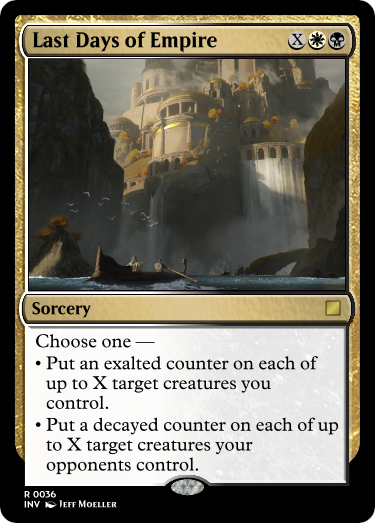
Last Days of EmpireXWB
Sorcery
Choose one—
- Put an exalted counter on each of up to X target creatures you control.
- Put a decayed counter on each of up to X target creatures your opponents control.
Art by Jeff Moeller
The prompt this week was to design a modal card with exactly two binary modes—one of them benefits you, and the other negatively affects an opponent. 'Binary' here was explicitly intended to exclude escalate, entwine, and similar mechanics that would let you choose both modes, and a further clarification on the Discord confirmed that the judges were looking for a very narrow definition of modal cards—specifically, cards with bullet pointed choices.
This week's entry was remarkably brain-to-post. I've always loved weird counters that actually matter in Magic—i.e. not just counters
used as a resource or to track the growth of an effect, but counters that have some sort of inherent porperties. We've been eating particularly
well on this front in recent sets, with Emissary of Soulfire
in MH3
giving us Exalted counters and Rot-Curse Rakshasa
in TDM
giving us Decayed counters. I always felt that Exalted and Decayed act as really interesting thematic parallels, and so it seemed natural to
pair these counters together on a modal card.
The only mechanical change was a few tweaks to casting costs and an earlier version having flashback to represent the cyclic nature of the rise and fall of nations, but that felt a little close to trying to cheese the "must choose between two modes" condition and so I cut it.
The flavour came equally quickly, with a clear thematic vision centered around the rise and fall of empires. Exalted counters worked as a glorious last hurrah of an empire of old, the uniting of the people in revolution against imperial tyranny, or as the heroic myth of the empire-forger (think Alexander the Great or Genghis Khan). Similarly, the Decayed counters wonderfully represented the collapse into decadence or the final sweeping away of the old order.
Mechanically, I liked a card that cared about combat but wasn't a simple combat trick—the beneficial mode has to be played before going to combat and allows you to hold back blockers while still making a big swing, while the negative mode acts as a slightly janky form of removal.
That said, let's see what the judges said:
There's a reason this card got some mentions in the workshop. What a fascinating approach. Keyword counters are harder to track with dice, but still, one can imagine that they're not going to be around for much longer. This card ends stagnant games for sure. I kinda wish you could make it different targets so that you could put multiple exalted counters on a single creature, but the way this spell has to work means otherwise, so there you go. I wonder if making X target creatures unable to block is a bend in BW, but it's part of black, so I suppose it's reasonable. The exalted counters are just perfect, though. I really love the BW approach to civilization from a color philosophy perspective—order and power, mattering in two quite different ways.
And the flavor feels majestic, even epic, which I recall being noted in your submission. I noted it myself and grok it for sure. A finale of valor, the strength of the people coming together to solidify a legacy for the ages—or, the crumbling remnants, the natural end to all kingdoms and rulers... Yeah, no, that tracks a lot. Exalted counters giving a single creature that heroic attack leaves all the others back to defend and pushes for a single strike. I would love to do this to force a block, honestly—swing in with the right creature in such a way that none of your opponent's creatures can kill it even if they all block. The decayed counter making them all basically attack or just sit there is really mean, too, but that's just how the story goes, how that other empire crumbled. Melancholy and old-school high-fantasy, good on ya.
All told, it looks like the card did what it wanted to do and did it well—another solid entry getting a deserved solid result. I do feel like I maybe need to stretch my design muscles a little more if I want to eek my way out of Runner Up Hell again, but for now I'm just glad to have hit a series of good results. The point about loading the counters on one creature is interesting, and I could definitely see the argument to reword the card to allow that, but that feels a little unnecessary so I'm not super beat about missing it when making the card in the first place.
Nexus of the Roil (Runner Up—Animated Adaptation)
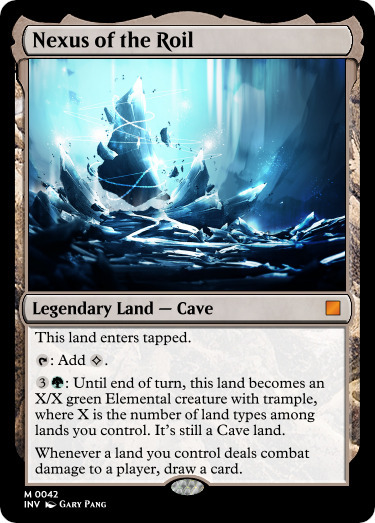
Nexus of the Roil
Legendary Land—Cave
This land enters tapped.
{T}: Add {C}.
{3}{g}: Until end of turn, this land becomes an X/X green Elemental creature with trample, where X is the number of land types among lands you control. It's still a Cave land.
Whenever a land you control deals combat damage to a player, draw a card.
Art by Gary Pang
The prompt for this week was to design a non-creature (and non-Vehicle) card that can become a creature.
The prompt was broad, allowing for all manner of corner cases—specifically called out was the possibility of using turning face-down as a valid form of 'transforming into a creature'—but while I toyed around with a few such designs, the one that I kept coming back to was the most obvious implementation of the prompt: man-lands.
In particular, I am a huge fan of the Restless cycle of man-lands from LCI, such as
Restless Anchorage
.
This cycle is distinctive in that while other man-lands may have attack triggers when turned into creatures, these lands are
uniquely templated so that the attack triggers happen whenever the land attacks, regardless of whether or not it
was animated by its own ability. So, while a Raging Ravine
will only accrue counters when it is animated by its own ability, a Restless Bivouac
will put a counter on a creature when it attacks even if you turn it into a creature with a separate effect, such as
with a Destiny Spinner
.
As a big fan of lands decks, this feels like a really exciting design space to explore. I wanted to expand on this space to look beyond basic attack triggers towards what other sort of effects could be triggered by lands being animated—whether by their own abilities or by another card. In particular, I liked the idea of an effect that affected all of your land creatures—again, regardless of how they became creatures.
I tried a few different ideas but eventually settled on a limited Coastal Piracy
effect
as a relatively simple and clean effect that wouldn't take up too much text space.
This brought me more or less to the final design, with the remaining tweaks mostly focussed on the exact particulars of the animation ability. An early draft was a more direct riff on Coastal Piracy (called Pirate Coast), a blue land that animated to become a pirate, but I struggled to find a source of evasion that fit a Pirate in blue without dipping into another colour, and I didn't want a lands build-around to require two non-Green colours in the deck to be viable given Green tends to house most lands-matters effects.
Eventually, I settled on the flavour of a mystical cave that was a node or nexus for Zendikar's roil. With this flavour
in place, I decided to introduce land types as a second "lands" theme that the card could play into. I particularly
like that this creates a flexible power ceiling for the card—in a lot of limited or standard formats, the creature
will top out at a 6/6 or perhaps a 7/7 if a non-Cave nonbasic land type is currently in the format, but in Eternal formats
like Commander this can be combined with cards like Omo, Queen of Vesuva
to create a two-card 15/15 for 5 mana out of your land base, which I think is fun.
That said, let's see what the judges had to say:
All told, I'd say the card mostly achieved what it set out to do. Looking back on it now, I do agree that the addition of 'lands-types-matter' as a further subtheme leaves the card feeling a little busy and unfocussed; definitely a reminder that some ideas are fun, but better put away to be reused on a later card design!
Coastal Expedition (Runner Up—Strangers with their Strange Lands)
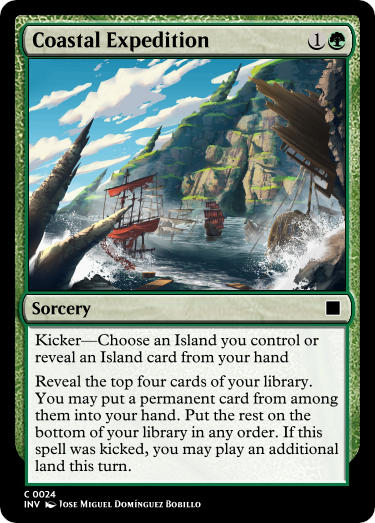
Coastal Expedition 1G
Sorcery
Kicker—Choose an Island you control or reveal an Island card from your hand
Reveal the top four cards of your library. You may put a permanent card from among them into your hand. Put the rest on the bottom of your library in any order. If this spell was kicked, you may play an additional land this turn.
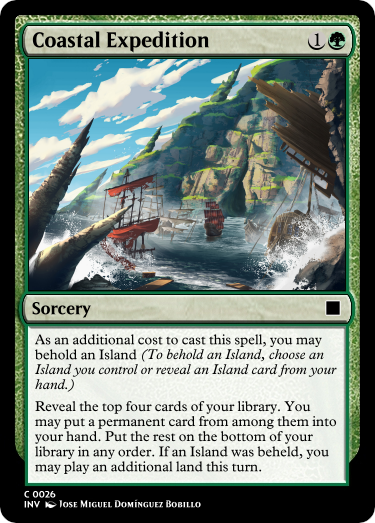
Coastal Expedition 1G
Sorcery
As an additional cost to cast this spell, you may behold an Island (To behold an Island, choose an Island you control or reveal an Island card from your hand.)
Reveal the top four cards of your library. You may put a permanent card from among them into your hand. Put an Island was beheld, you may play an additional land this turn.
In the above images, the first version is the version submitted for the contest—the second version represents the version I wanted to submit, and what I consider the definitive version of the design, but which I was unable to put forward because Tarkir: Dragonstorm had not yet released and so behold was not yet a released keyword.
The prompt for this week was to
design a monocolored card that cares about a basic land type that IS NOT aligned with its color.
Further updates confirmed that (1) the judge was not looking for punisher or hate cards (e.g. no Boil
effects) and
(2) they were looking for cards that reference ONLY ONE land type (so no Wild Nacatl
-like designs.
My first thought when designing for this contest, like a lot of peoples', was to take a straightforward scaling effect and simply have
it scale with a flavourfully appropriate land type. An early draft for this type of approach was an Overrun
that scaled
off mountains, flavoured as a downhill charge.
Downhill Stampede [2GG]
Sorcery
Until end of turn, creatures you control gain trample and get +X/+X, where X is the number of Mountains you control.
However, I quickly found that I was struggling to cost this card in a way that I felt satisfied with, and I also felt like it wasn't
sufficiently flavourfully distinct from Downhill Charge
, even if
it serves a very different mechanical function. And, all told, I simply was not excited about the card, so I decided to try a different tack.
Instead of focussing on scaling effects, I thought it would be interesting to explore binary effects—i.e., effects that are turned on
by having access to the off-colour land. I've been having a lot of fun with Explore
effects recently,
so this instantly made me think of Joint Exploration
as an example
of this kind of effect that gets better when you have access to a second colour, in this case filtered by a green pip in the kicker cost.
At about the same time, I was starting to look at spoilers for the new Tarkir: Dragonstorm set, and I was instantly struck by the sheer
versatility of the new Behold a [Quality] mechanic, represented in this set only as Behold a Dragon. Putting two and two together,
I realised that Behold a [Land-type] was an incredibly flavourful thing to write on a card all about exploration, and these two lines of thought
quickly came together to create a Malevolent Rumble
/Planar Genesis
-type effect
that allowed you to draw one from the top four of your library and, if you beheld an Island on your travels, get the Explore effect to put a land
into play.
This, however, is the part where our tale gets a little bit sad, as it were, because when I took the design to the discord it was pointed out to me that behold is not yet a released mechanic and, as such, was inadmissible to the competition. I found this very frustrating, as I really liked the flavourfulness of 'beholding an Island' as you explore the coastline, but I still felt that the core concept of the card was strong, so I decided to simply bite the bullet on this one and retemplate it to remove the offending keyword.
That brings us to the actual results and what the judges had to say:
I...love how this card feels. I can't fully explain it. But I love how it feels. This is what really messes me up, right? I'm gonna ramble here and it's gonna make no sense but dammit, it's a feeling. Green and blue are a lot closer than I think people give them credit for, at least from an elemental standpoint. Yeah, there's wizardry vs. nature, and perfectionism vs. letting things be, but we're talking about pure, unbound elements. Water IS nature. The ocean and the land, lakes and forests—they vibe with each other. You know? Jace and company can talk about intellect and illusion and whatever all they want. I contend that, as this card represents, the ease of water and the paths of nature are one and the same. With the context of an expedition, the human heart can allow itself to journey with that same ease. I stand by that.
Anyway. Card's deec, too. There's the smallish issue of kicker and "choosing" as an additional cost, and maybe that's possible, but I think you might have overlooked a simpler solution. You know the Dragon-revealing stuff that happened throughout DTK? Silumgar's Scorn and that cycle. The idea of optional additional costs doesn't have to be kicker. Draconic Roar and those kinds of cards. Looking at these cards, I can see how choosing works (Dragon's Fire, funnily enough), but I feel this card could've been cleaner without it. Just like, "you may reveal an Island card from your hand" and then you can play an additional land if you did OR if you control an Island as you cast it. But that's just the polish on a card that's 98% of the way there already, so please take my first paragraph's praise as the main commentary here.
First take away is that the judge seems to have got what I was going for with the flavour on this card, which is really gratifying as I felt like the flavourfulness was really the heart of why I considered this such a strong entry.
On the templating point, I can definitely see where they're coming from, but as they note there is already precident for choosing in an additional cost and, more importalty, as I explained here, this all comes from a place of wanting to evoke the same flavour as the behold mechanic, which I do stand by as a decision even if it makes the card 2% more clunky than it needs to be.
Kin-Tree Grove (Winner—Solid Ground)
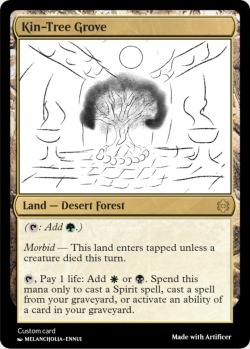
Kin-Tree Grove
Land—Desert Forest
({T}: Add {G})
Morbid—This land enters tapped unless a creature died this turn.
{T}, Pay 1 life: Add {W} or {B}. Spend this mana only to cast a spirit spell, cast a spell from your graveyard, or activate an ability of a card in your graveyard.
Art by me
The prompt for this week was to design a nonbasic land with a flavorful focus. There were a few additional rules/requirements which you can read in the post, including a request for original art—hence the sloppy sketch I threw together on my phone that you see in the art box of the card image above.
My concept here was quite simple—I really like the lore of the Abzan, and wanted to create a land that would evoke the Abzan connection to the ancestors and especially the religious practices around the kin-trees. This starting point told me two things about the card: (1) it had to produce the full Abzan colours (i.e. white, green and black) and (2) it had to care about the graveyard and/or past.
I worked out early on that I wanted this land to be a Forest, even though the Abzan are properly centered in white, because I really wanted the kin-tree to feature centrally throughout the design. Early drafts pulled in two different directions. One was a series of designs riffing on the [[Verges]] from Duskmourn/Aetherdrift, i.e. lands that naturally produced one colour of mana (here green) but which could produce other colour(s) once certain conditions were met. I think the best version of this design used a mechanic I called "Remembrance" that allowed you to tap it for black or white if there was a creature card in your graveyard, but of course that condition is far too easy to reach and so it felt like a very clunky design that would ultimately just function as a triome in play. The other design direction involved an activated ability costing black and white instead of any fixing, usually involving making Spirit creature tokens. There was even one iteration where I tried to do both of these—that was a very clunky card!
Eventually, I decided that I really liked the idea of using Morbid as the condition for this land entering untapped, as Morbid hasn't yet appeared in the text of a land and I thought that created some potentially really interesting play patterns, encouraging you to hold your land drop until after combat in the hopes that your opponent will make a block. That told me that I didn't want another flavour word in the text as it otherwise looks very cluttered, so the various versions on "Remembrance" got scrapped and I had to find a different way to limit the fixing to prevent goodstuff mushes in the hypothetical limited environment in which this would appear.
I decided that the best way to do that was to only let you spend the mana on certain things. To drive home the death and dying theme, I decided to focus on one thing the Abzan have historically cared about—Spirit creatures—and two things they could conceivably care about, namely spells and abilities in the graveyard. This came with the added benefit that Sultai decks would likely also want this card for fixing their graveyard spells/abilities, which added a bit of extra utility to the card and made it a bit more contested in its imagined draft environment.
The final flavour touch that I am quite proud of is the one life payment in the second ability. This is not just an homage to Mana Confluence, fecthes, and the Horizon Lands; it is also intended to thematically represent the player pouring out a libation to the ancestors in order to curry their favour.
With all that said, let's see what the judges said:
I don't need to espouse how awesome the flavor of this card is, but it's my job, so I'm going to do so anyway. Connecting the Abzan to their ancestors is perfectly represented here, and though it's been a long time since I've read up on Tarkir lore, I do remember some of those connections, and how important that ancestry is to the desert family. The life that is to be found in the desert, this strange stubborn oasis, allows for a connection beyond life, through life, and I'd like to think that the visitors to this tree can feel that when they tap into that mana. Living spirits and the power beyond are bound here, and I think that you did a lovely job demonstrating that.
Overall, I am very happy with these comments, as I feel like they show that I lot of what I wanted to achieve with this card really came through!
Karus, with Waxen Wings (Runner Up—Myth ReRealized)
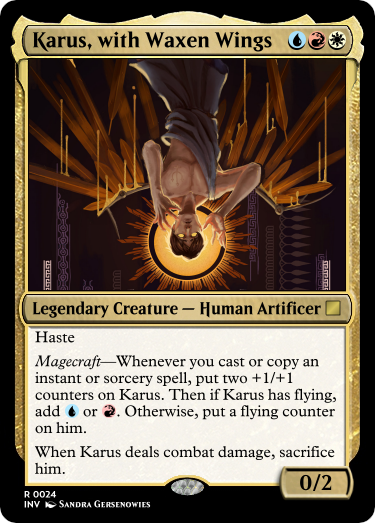
Karus, with Waxen Wings URW
Legendary Creature—Human Artificer
Haste
Magecraft—Whenever you cast or copy an instant or sorcery spell, put two +1/+1 counters on Karus. Then if Karus has flying, add U or R. Otherwise, put a flying counter on him.
When Karus deals combat damage, sacrifice him.
[0/2]
Art by Sandra Gersenowies
The prompt this week was to design a card that alludes to a piece of real-world mythology.
This week I actually had three initial ideas that I took to the Discord—a mono-blue legendary based on the story of Honi the Circle Maker, a fairly bland Azorius sweeper based on the story of Noah's flood, and the earliest germ of the design I ended up going with, one based on the story of Icarus and Daedalus. I was actually most excited about the Honi card, but several design iterations proved continuously overcomplex and hard to cost, so I set it aside and tried to develop this one instead.
The prompt indicated that 'submissions make an effort to be not quite one-to-one with the source'—in other words, the goal was not to make Icarus, the
card, but rather to make an original Magic character that evoked and drew upon the myth of Icarus. More
Alrund, God of the Cosmos
being an obvious Odin expy and less Socrates from the Assassin's Creed set
. In order to
ensure I captured this dimension of the prompt, I wanted to pair the original myth with a Magic mechanical substrate that captured the same basic themes of
the theme but which added something absent from that original myth through its ludonarrative implications. After a few different iterations, the mechanical base
I settled on was Storm: like Icarus, the storm player flies close to the sun when they choose to dump their resources into a storm turn, and like
Icarus they may fall if they fly too high and the storm turn fizzles. Besides this close thematic pairing, storm implies reckless spell-slinging in the
fiction of Magic, which felt like a nice twist on the largely mundane character (if technologically gifted) of Icarus in the original story. Thus, Karus was
born.
There were three main design goals I had with this card. Firstly, I wanted it to function as a storm pay-off: you should be able to pump a bunch of spells into it and get lethal damage out the end as a result. Secondly, I wanted to make sure you only got one shot. That's really what the third ability is all about—you get one shot, and if you mess it up, Karus falls. I also really wanted something to make the card feel fragile—there should be lots of ways your opponent could, potentially, force it to deal combat damage, so you can't just sit on it as a huge blocker that accrues value over time— you have to go for the win as soon as possible.
Most of the feedback I got from the Discord was about pairing the card down to something manageable—an early draft of the card included Prowess
as well as Magecraft, which was a lot to say the least! It was also during this iterative stage that I added the mana generation aspect of his second
ability, both to lean a little more into the spellslinger character of Karus as distinct from the mythical Icarus, and also to give him a more robust home in a
Storm deck as an enabler alongside cards like Birgi, God of Storytelling
.
The one piece of feedback that I got that I never quite had a good answer too was a question as to what the white mana in his casting cost was doing, exactly. What about this card wouldn't fit perfectly well, if not better, in Izzet as in Jeskai? My only answer here was purely vibes based—I tried taking the white out and it just felt wrong. Honestly, my personal gut feeling is that Icarus is more of a Boros character philosophically. Honestly, everything this card does, red can do, so it might even have been possible to do this card in Boros colours—but then the white would probably feel even more out of place, and having blue as the second most spellslingerly colour in the card's identity definitely feels right.
With that all out of the way, let's hear what the judges had to say.
Overall, I am very happy with this feedback. I am kicking myself a little at the 'on Waxen Wings' comment because, honestly, that is just a better name for the card, but I just didn't see it!
As for the comment about haste, I do actually feel it's quite important for the card, because it means you can still use him for a combat win if you draw him in the late game. If you have six or seven mana open, it's very possible to drop Karus, shot off a couple of 1-mana spells for a net cost of only 1 more mana, and then use the remaining two or three mana you have available to try and cantrip through your deck enough to get him big enough to finish off whatever life your opponent has left if they don't have the blockers to stop him. I also do feel it is thematically necessary, if nothing else, representing the sheer recklessness of Icarus's flight into the heavens, and the actual cost of one extra line in the text box for a single additional evergreen keyword isn't that high.
Warden of the Witchlight (Winner—Garbage Day)
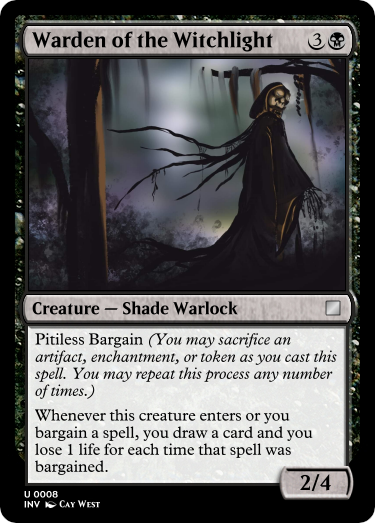
Warden of the Witchlight 3b
Creature—Shade Warlock
Pitiless Bargain (You may sacrifice an artifact, enchantment, or token as you cast this spell. You may repeat this process any number of times.)
Whenever this creature enters or you bargain a spell, you draw a card and you lose 1 life for each time that spell was bargained.
[2/4]
Art by Cay West
The prompt this week was to design a card that can sacrifice a noncreature permanent type.
I knew right away that I wanted to do something with Bargain, a WOE mechanic that I absolutely love and which has seem some continued support
with the enchantment sacrifice subtheme in DSK. In particular, I wanted to mess around in the design space of a "multibargain" effect—that is,
the multikicker to Bargain's kicker. My initial draft for this card just cared about how many times it itself was bargained, but feedback on the
discord pointed out that this seeemed a little close to Malevolent Witchkite
. As the main
reason I wanted this effect to be a Bargain variant (and not an unkeyworded ability like Malevolent Witchkite's) was because I wanted to facilitate
Bargain support cards that cared about both this new mechanic and the original Bargain, I opted to rework the card into one of those bargain support cards
that I was imagining. Thus, I decided to tweak the draw effect to check for both its own bargaining and for any other bargains you might make while you
control it.
With that, all we needed was a flavourful keyword to express the idea of ruthless bargaining away your entire board for a modicum of power—Pitiless Bargain seemed a good fit—we were ready to submit. Now let's take a look at what the judges said:
All told, that's pretty much what I was aiming for, so a good solid result for a good solid entry!
The Notorious Snatcher (Runner Up—But No Cigar)
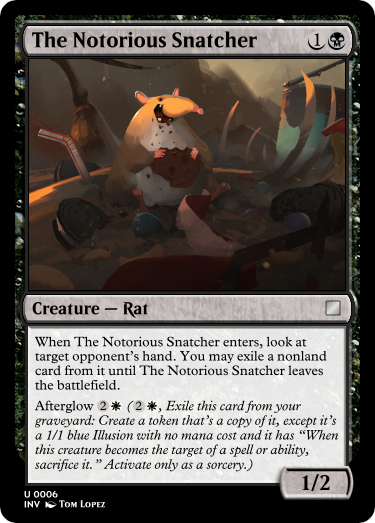
The Notorious Snatcher 1b
Creature—Rat
When The Notorious Snatcher enters, look at target opponent's hand. You may exile a nonland card from it until The Notorious Snatcher leaves the battlefield.
Afterglow 2w (2w, Exile this card from your graveyard: Create a token that's a copy of it, except it's a 1/1 blue Illusion with no mana cost and it has “When this creature becomes the target of a spell or ability, sacrifice it.” Activate only as a sorcery.)
[1/2]
Art by Tom Lopez
The prompt this week was to design a card that creates a copy with modified attributes.
I toyed with a couple of ideas for this week but quickly felt pulled back to the Afterglow mechanic I developed for the
Anointed Paladin
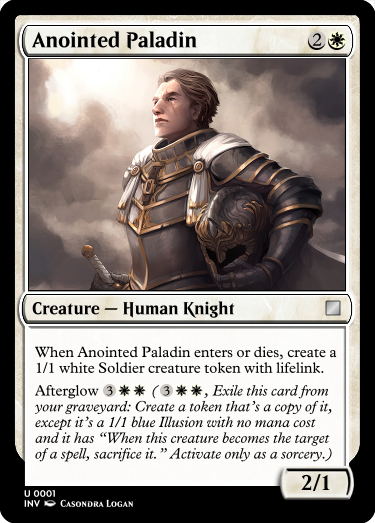 card
from a few weeks ago. I had really enjoyed playing around with that mechanic, and while I felt that the Anointed Paladin gave a good
initial showing, I felt there was a richer design space here to explore.
card
from a few weeks ago. I had really enjoyed playing around with that mechanic, and while I felt that the Anointed Paladin gave a good
initial showing, I felt there was a richer design space here to explore.
I mentioned in my discussion on Anointed Paladin that my original idea for that first card was a Banisher Priest
-type effect, but that
I opted not to follow that design route after finding Angel of Sanctions
. While I still didn't
want to just make Angel of Sanctions II, I felt that if I was going to double-dip in Afterglow, it would make most sense to explore
the other half of the design—Anointed Paladin explored using the Illusion ability to help you get a creature that you want to die off your
board, so this week I wanted to explore the space of using the Illusion ability as a weakness that helps your opponent get an Annoying Bastard off your board.
Banisher Priest-like effects were out for now, and I wanted to try and explore a different colour space for the design as well, so these constraints together
eventually led me to Kitesail Freebooter
/
Deep-Cavern Bat
effects.
With a mechanical concept in place, it was just a matter of finding a flavour to match. Afterglow was intened to evoke the idea of legacies and memories—that even once the creature has passed, its memory may go on to inspire new generations. I played this straight for Anointed Paladin and so I wanted to be a little subversive this time—what instead of inspiring generations to come, we had a memory that tormented generations; not fame, but infamy. This eventually lead me to the idea of folk monsters, and in particular, the idea of a rat that keeps stealing food from the pantry; but is it just one exceptionally talented rat-thief, or is it just an infestation of rats that resembles the antics of a single, talented pilferer?
I called the card The Notorious Snatcher, intending to evoke the idea of a legacy of rats stealing food, and took the idea to the Discord for
feedback. Particularly helpeful in developing this design was feedback from @3smuth++, who pointed out that there was a weird conflict between
my choice to use the new Illusion mechanic (seen in Dream Strix
), which only sacrifices the
creature if its targeted by a spell, with the way that this kind of card interacts with card advantage: forcing players to spend a card to remove a threat
which did not cost a card to put out is always going to result in a 'feels bad' moment, even if the illusion effect allowed non-removal spells (such as buff spells)
to flex into that slot. Their advice was to try and find some other ability that could lead to more interesting re-evaluations of the original card, but advised
that if I was committed to the Illusion ability (which I was), I should think about using the old Illusion ability seen on cards like
Gossamer Phantasm
, which would at least
allow the token to be removed by spare abilities that might not cost anything at all.
I liked this idea, and so I revised the design to the final version seen above. (Note: I consider this an errata of the text of the Afterglow ability, so please do read the Anointed Paladin using the new text as well!)
This was my first runner-up result, so I was excited to see what feedback the judge would provided. This is what I got:
So, immediately, I'm a bit dubious about the use of "The" in the name here. It's not legendary, so how many The Notorious Snatchers could there possibly be? At any rate, funny how Afterglow keeps coming up, eh? Good to see you're still experimenting with it. This definitely feels like a design enabled by Afterglow rather than just showing it off, and it's also uniquely Afterglow. After all, getting a second copy of this effect is quite strong, but the interesting part is that it actually makes the creature more vulnerable to being removed, which therefore makes the effect less powerful. I'm a bit dubious of the Afterglow cost being white, however, just because I'm not entirely sure monowhite should have access to this kind of effect if they manage to dump this straight to the graveyard. I'd be interested to hear the logic behind it, certainly.
To which I can only say: yeah, fair.
On the first point, you'll notice that in my concept I had this idea of a bit of a puzzle or mystery, is this just one really successful rat or is it a legacy of generations of rat pulling off ratty heists? You will also notice that literally nothing of this concept made it onto the final card, neither in art nor flavour text. So while this is where the 'The' in the title of a non-legendary came from, it doesn't really make sense in the final design, and I should've committed one way or the other—either ditching the 'The' or making it a Legend (probably the former!).
Regarding colours, I genuinely did not even consider that you might try to run this in a deck that could not play it out of hand on the off-chance you could dump it in grave with a mill or discard and then get its graveyard effect, but honestly, I know the Reanimator archetype, so that's very much a use case I should have thought of. To remedy this, I think I would change the cost of the second ability to 1wb. I want to keep the white in there, because I also wanted this idea to play with using Afterglow as a reward for dipping into a second colour (effectively allowing you to double up on one of your key removal pieces if you did so), but I definitely don't want this to be available to mono-white graveyard decks, so having both feels like a good compromises—as well as doing a better job of sign-posting that the white pips are supposed to encourage multi-colour play.
Enduring Legacy (Winner—All That Remains)
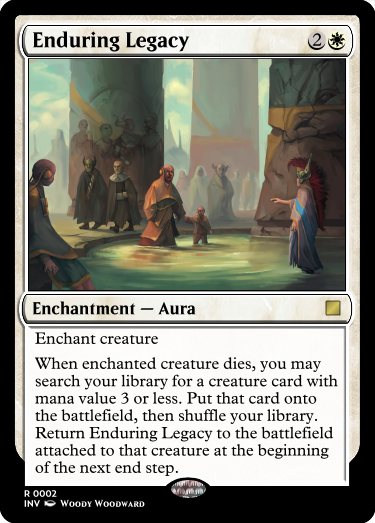
Enduring Legacy 2w
Enchantment—Aura
Enchant creature
When enchanted creature dies, you may search your library for a creature card with mana value 3 or less. Put that card onto the battlefield, then shuffle your library. Return Enduring Legacy to the battlefield attached to that creature at the beginning of the next end step.
Art by Woody Woodward
The prompt for this week was to design a card that, flavorfully and/or mechanically, utilizes the concept of HOPE..
I found this week a very difficult one to get started on. The prompt was vague, and flavour-first at that, which meant building a mechanical identity for the card from the ground up. My first couple of ideas (some kind of anti-poison protection spell and a green sweeper broadly evoking the theme of standing alone against a tide of monsters) both felt 'off' somehow, and once they got whittled down further by feedback on the Discord they just didn't really 'spark joy'. I was actually very close to just submitting the sweeper and phoning it in for this week, but one last idea was niggling at the back of my mind so I thought I should at least give it a go.
The concept was to lean into the idea of legacy—the hope that comes from carrying the torch for those that came before and handing it on to the next generation. It's a topic I've been thinking about a lot, recently. Reckoning with my baby siblings getting their first jobs and going off to uni has got me thinking about my hopes and fears for them and the world they find themselves in, which is in many ways even harsher than it was when I was going through the same things. It's also got me thinking about how I can be a good older sibling to them—how I can be there for them in the way that I would've wanted. I wanted to create a card that captures something of this bitter-sweetness.
Once I had this theme laid down, the initial design came quite quickly. My first draft was as follows:
Enduring Legacy [1WW]
Enchantment—Aura
Enchant creature
When enchanted creature dies, you may search your library for a creature card with lesser mana value than that creature. Put that card onto the battlefield, then shuffle your library. Return Enduring Legacy from your graveyard to the battlefield attached to that creature.
I always wanted the card to be in white, a colour which has tradition, hope, and community as key themes.
Looking to Ranger-Captain of Eos
,
Ranger of Eos
and
Recruiter of the Guard
,
I noted that while white can tutor for creatures, it usually requires the tutored creature to be appropriately small—tutoring for
creatures of any size is pretty firmly green. As such, I added altered the condition to be 'search your library for a creature card
with mana value 3 or less and with lesser mana value than that creature
'.
This was the version of the card I took to the Discord for review. @MyojinOfNightsReach pointed out that the mana cost
was probably too restrictive for what it does, and that I should probably consider having the aura return on end step like
Gift of Immortality
to
prevent abuse with a sac outlet. He also suggested that at 3 mana and returning on the end step, I could probably drop the 'lesser mana'
restriction. I liked this change from a flavour perspective as well—the original flavour of the 'lesser mana value' clause was one of
fading glory the further one gets from the heroic ancestor, a pretty common fantasy trope but one that is inherently both somewhat reactionary
(strong 'retvrn' energy) and not especially hopeful. Allowing the descendents to potentially 'outshine' the predescessor (by searching for a
3-drop after placing this enchantment on a 2-drop, for example), the theme became much more reminiscent of the ebb and flow of wisdom across
generations, which felt both more true to life and more in line with the theme of hope. Applying all these changes got me to the final
design, shown above.
The judge gave the following feedback:
Lol @ the "Enduring" cycle from Duskmourn. I was just trying to think of where that cycle came from as I was looking at this card, and then it struck me. Not that this has anything to do with that, but all the same... I was thoroughly impressed the first time I read through it and I'm still impressed with it now. Of course, I think that it's an absolute nightmare to deal with, but that's also because I'm a hatebears fan, and I want to chain together Skyclave Apparitions and tutor with a sac outlet for my Adelines and Thalias. The more I talk about it the more I feel that this card could use a little less power somehow but for the time being, be thankful you can get away with me wanting to be evil. So, so evil.
Does that have anything to do with hope? Conceptually, not really, because this card may be a come-from-behind kind of deal but it's less about that and more about the celebration of life, I feel. The death is not so much death as it is a passing-on, and the representation here just happens to align with a gameplay strategy that my brain wants to, ah, "inflict on" other people more than "play with." That's okay, power is okay! Children and parents and society's passing-on of information and strength is indeed vital to the concepts at large. No knocking ya there.
All told, these feedback feels more like patting on the back than anything—it highlights the key themes and, indeed, play patterns I was hoping to evoke. (Well, not quite the same on the play patterns—I was more imagining this as a tool for aggro white weeny decks to maintain tempo than as a way to cycle through hate bears, but the the main idea that it allows you to have a sort of pseudo-protection and/or toolbox was there.) This admittedly means I don't have much to go on when it comes to improving for future submissions, but honestly I feel like this is one case of just a really nice, tight design, and so I am happy to more or less leave it at that.
Anointed Paladin (Winner—Tricks of the Grave)

Anointed Paladin 2w
Creature—Human Knight
When Anointed Paladin enters or dies, create a 1/1 white Soldier creature token with lifelink.
Afterglow 3ww (3ww, Exile this card from your graveyard: Create a token that's a copy of it, except it's a 1/1 blue Illusion with no mana cost and it has “When this creature becomes the target of a spell, sacrifice it.” Activate only as a sorcery.)
[2/1]
Art by Casondra Logan
The prompt for this week was to design a card with an activated ability that can't be activated on the battlefield.
I've recently been enjoying brewing with Timeless Witness
in Commander, and I
really enjoy how Eternalize allows you to use her effect twice, once in the early-mid game and again at a second, later point. As such, I thought this prompt
would be a great opportunity to explore this kind of design space more by creating my own Embalm/Eternalize-type ability.
I've also been a big fan of Dream Strix
and the Illusion ability
(as is now—I believe this effect used to be tied to the Spirit type but was moved to Illusions by R&D). By forcing the creature to sacrifice itself
when targetted by a spell, the Illusion ability creates a very interesting and open-ended design space—it can be used as a strength of the card, as
in Dream Strix, allowing you to get a death trigger without depending on finding a sac outlet or using an opponent's board or actions; or it can
be used as a drawback that makes an otherwise scary creature more manageable, as is the case with
Phantasmal Dreadmaw
, a terrifying 6/6
for 4 with Trample which uses the Illusion ability as a built-in vulnerability that justifies its hyper-competitive rate.
Putting these two ideas together gave me the concept for Afterglow, an Embalm/Eternalize variant that returns the creature as a 1/1 Illusion copy with the Illusion ability. The flavour here is intended to be a memory or legacy made manifest, rather than a literal haunting spirit.
This led to two main questions—
- On a mechanical side, what kind of abilities would synergise well with an ability that creates a more vulnerable token copy of the creature?
- On the flavour side, what kind of character would inspire a memory or legacy?
My first thought for the first question was some kind of hate bear or stax piece. In this case, the Afterglow ability would allow you to recycle back your hate bear while ensuring that the returned copy is much easier for your opponent to remove, acting as a kind of counter-balance to the inherent pressure that recycling an oppressive stax piece poses. While I still think this presents an interesting direction to take the mechanic, I felt that it didn't really capture what originally made me excited about an Embalm/Eternalize-derived mechanic—i.e., the possibility of repeating a powerful ETB effect.
I then spent some time looking at white ETB effects that would fit this space, and briefly considered a Banisher Priest
-type effect. I actually
really liked this idea, as it seemed to marry the two underlying concepts I was playing with quite well—on the one hand, getting two
Banisher Priests for one scratched that 'doing the cool thing twice' itch quite nicely; on the other hand, this made good use of the
vulnerability of the Illusion token, allowing your opponent to more easily remove the removal and get their creature back by targeting the token
with any spell. Unfortunately, while toying with different flavour ideas, I came across Angel of Sanctions
,
which does this exact concept using Embalm. The overlap here was just a little too much, and I didn't want another of my designs to be read
as too derivative, so I decided to shelve this version of the design.
All this conceptualising brought me back to Dream Strix and its on-death trigger. I realised that there are several creatures—such
as Ashen Rider
and
Patron of the Arts
—that have
abilities that trigger on both e.t.b. and death, and that this kind of effect would also synergise very well with my Afterglow concept.
Having an effect on both e.t.b. and death with Afterglow allows you to get the effect four times—original e.t.b., death of the original,
e.t.b. of the token, and death of the token. With the token's self-sacrifice ability, you effectively have access to the final death trigger
at any point when you have a spell that targets available.
This idea, alongside my answer to the flavour question, brought me to the final design for Anointed Paladin—a holy paladin whose feats of heroism inspire others to rise up in defence of the cause. Their memory returns as an Illusion to inspire again, allowing you to gain four tokens across the game.
This design actually underwent less development through the Discord than most of my entries—I was advised to drop the rarity from Rare to Uncommon, but other than that the feedback focussed on my other design for this week (a cycling card), which I ultimately decided was just a weaker entry than this one.
So, with the concept out the way, let's have a look at the judge's comments:
Okay, let's get this out of the way straight out of the gate: Afterglow is ultimately a variant of Embalm. However, a) I like Embalm and think there should be more of it and b) I would say that does some serious work in setting itself apart that I appreciate. Principally there's the reversal of the dynamic: while Embalm was just another copy of the creature and Eternalize was primarily interested in making it bigger than before, Afterglow actually makes it considerably weaker, which I feel like opens up enough new design space. Interesting how the illusion self-destruct clause doesn't include being targeted by abilities, though. Was that intentional? Well, at any rate, the card itself is a perfectly fine showing of the mechanic, putting more emphasis on what the creature does than what it is in both forms. I'm struggling to figure out the precise flavor of Afterglow—maybe it's just a memory of them rather than any sort of spirit— but that's not a knock against it; on the contrary, I'm interested enough to speculate.
Overall, I'm very happy with this feedback—it caught the key appeal of the concept, and gave it a fair shakedown. I'm glad the judge was also an Embalm enjoyer, as I risk otherwise I might have caught some flack for being too derivative again, although I stand by the claim that any such criticism would be unjustified for exactly the reasons the judge's comments indicate.
Lessons learned. So, what can I learn from the success of this design? I would say there are two main take-aways:
- Push the boat out. This design was a little more risky than some of my previous designs, and in this case I feel like it worked really well. Sometimes I get too focussed on sticking within the space of what's been done in Magic, and forget that the point of designing new cards is to push those boundaries one way or another.
- Don't just go with your first design. My first thought for this week was a cycling card, which I ultimately abandoned. As you can see from the design discussion above, even once I focussed in on this idea it went through several iterations, and this really helped nail down a final design that was much stronger than any of the iterations running up to it.